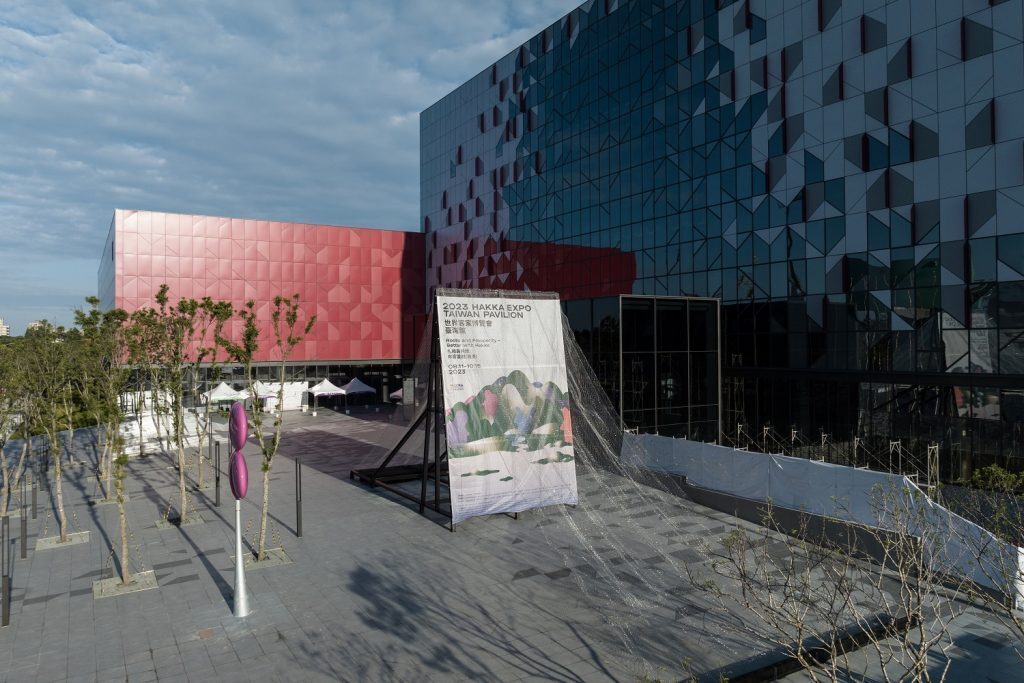Successful Closure of the 2023 Hakka Expo – Taiwan Pavilion Showcases the Milestone of Better with Hakka and Cultural Harmony

▲ Over the course of 66 days, the 2023 Hakka Expo successfully closed. Photo credit: 2023 Hakka Expo official website
The 2023 Hakka Expo, the largest international cultural festivities in Taiwan this year, officially concluded on October 15th. Over the course of 66 days, the expo drew in over 11 million in attendance. The Taiwan Pavilion, themed “Roots and Prosperity – Better with Hakka” received widespread acclaim both nationally and globally. It not only attracted a multitude of visitors from all across Taiwan but also won praise from international guests for its rich and captivating exhibits. Families of all ages, from the young to the elderly, came to experience new Hakka aesthetics, expressing their hope that the exhibition will endure to increase public understanding and recognition of Hakka culture. Taiwan Pavilion: A Microcosmic Encyclopedia of Taiwan’s Hakka Culture The Taoyuan City Government’s Department of Hakka Affairs stated that the 2023 Hakka Expo is the first world-class exposition in Taiwan to shed light on ethnic culture. The overarching theme “Travel to Tomorrow (天光日个客家)” illustrates Taoyuan’s unique characteristics in a discourse on a prosperous future with various ethnic groups. As one of the major and largest pavilions spanning over 10,000 square meters, the Taiwan Pavilion has theme exhibition zone of 1650 square meters and brings together 14 key Hakka counties and cities. The exhibition space is centered around the Hakka 369 concept that presents a brand-new look of Taiwan on its richness, diversity, coexistence, and integration of Hakka culture.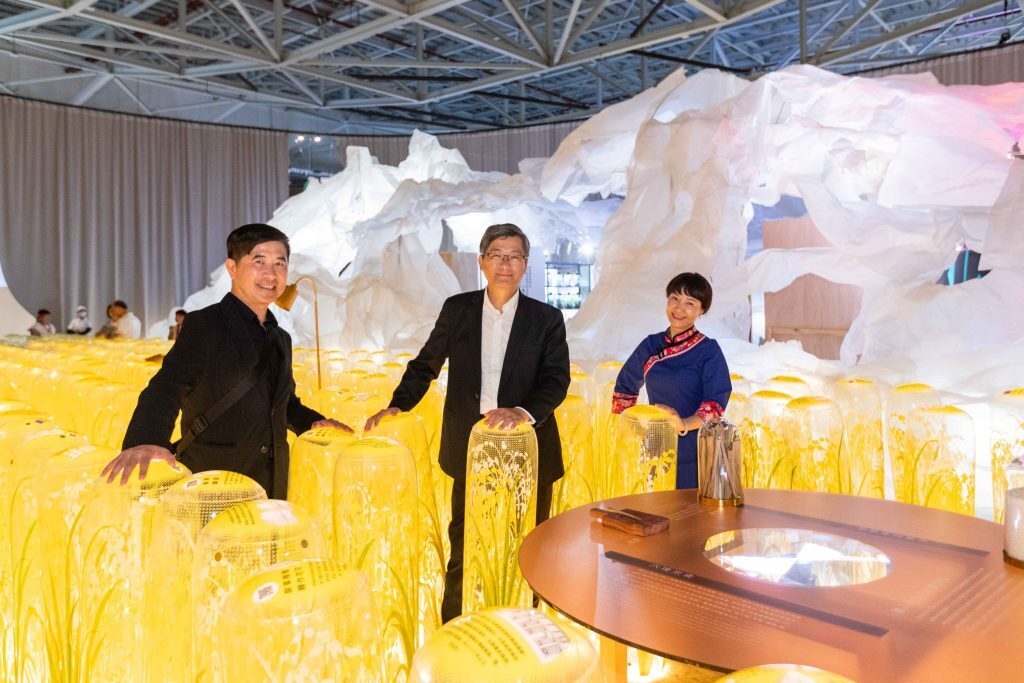
▲ President of the Taiwan Design Research Institute, Chi-Yi CHANG (left) with Minister of Hakka Affairs Council (central), Yiong Con-ziin, in Taiwan Pavilion.
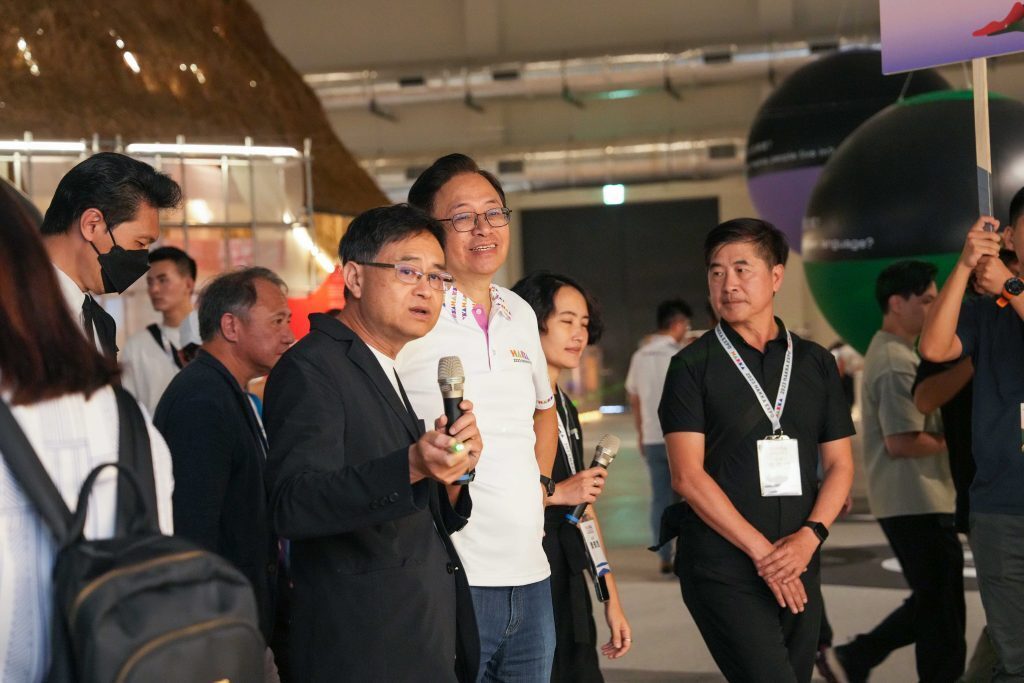
▲ Oliver Lin, Deputy Director of the Taiwan Design Research Institute introduced the exhibition to Mayor of Taoyuan City, Chang San-Cheng.
Oliver Lin, Deputy Director of the Taiwan Design Research Institute who curated the Taiwan Pavilion, explained that its theme “Roots and Prosperity – Better with Hakka” serves as a multifaceted Hakka encyclopedia that offers an overview of cultural features in Taiwan and its dynamic evolution across time, space, and society. Regional areas function as ethnologies that encapsulate diverse and distinct aspects in local contexts. Lin also stressed that this year extends beyond physical exhibits, large-scale installations, and static infographics to incorporate technology in immersive theater, mobile interactions, and motion-sensing activities. The goal is to educate the audience on the profound Hakka legacy with various displays and entertaining experiences. Theme Exhibition Zone: A Creative Interpretation of Hakka Modernization Even before entering the Taiwan Pavilion, visitors are astounded by the colossal visual installation adorning the façade. Nora Wang, Co-founder of JC. Architecture & Design who curated theme and public areas, expressed that this year departs from conventions by extensively adopting cloth to convey the steadfast, gentle, and tender Hakka spirit. Various textures and colors of the fabric drapes from the outside to indoors, symbolizing the humble yet resilient nature of the Hakka community who shine their light in respective fields across Taiwan. Notably, public paper seating and resting zones not only represent their traditional emphasis on education and writing materials but also signifies their commitment to recycling and reuse today. This clever implication of their respect for nature and resourcefulness aligns perfectly with UN SDGs.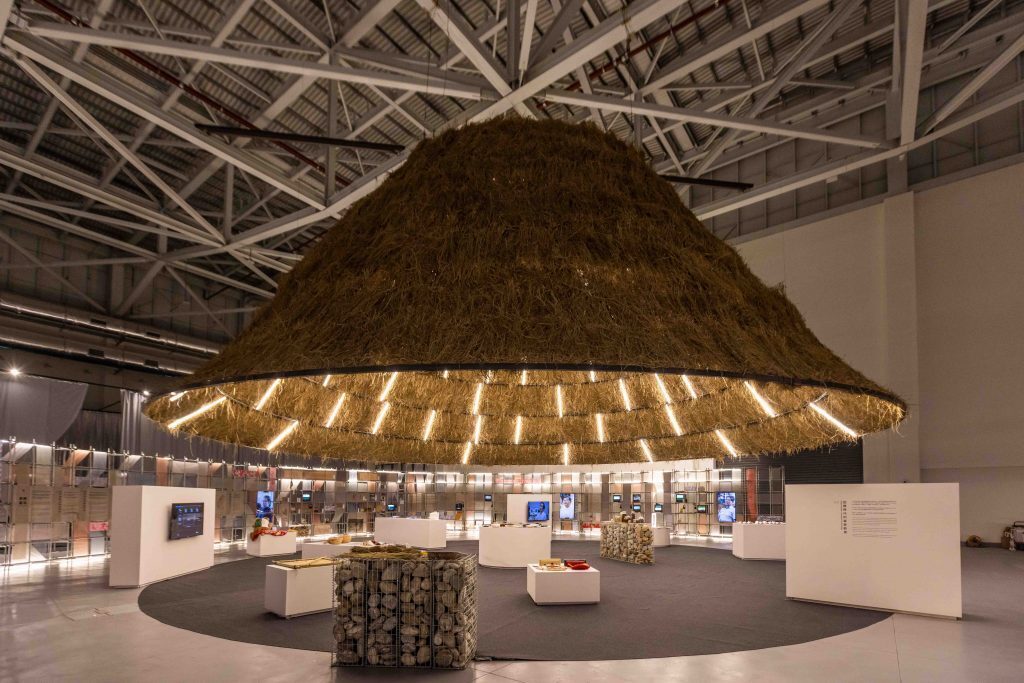
▲ Theme Exhibition Zone 「Adapting Taiwan」
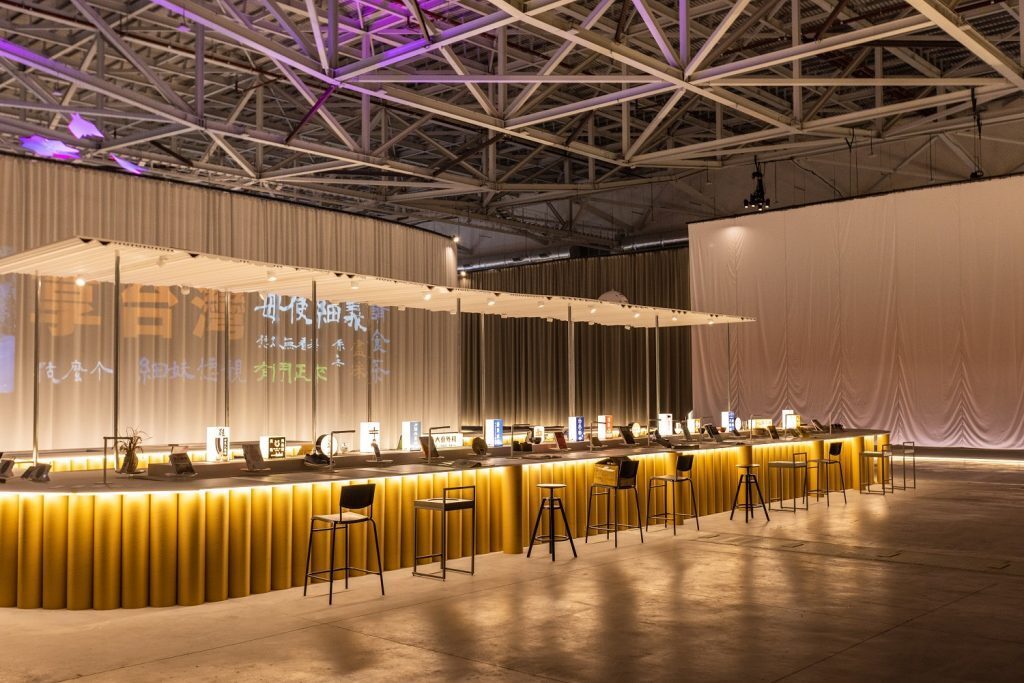
▲ Theme Exhibition Zone 「Taiwan, a Shared Treasure」
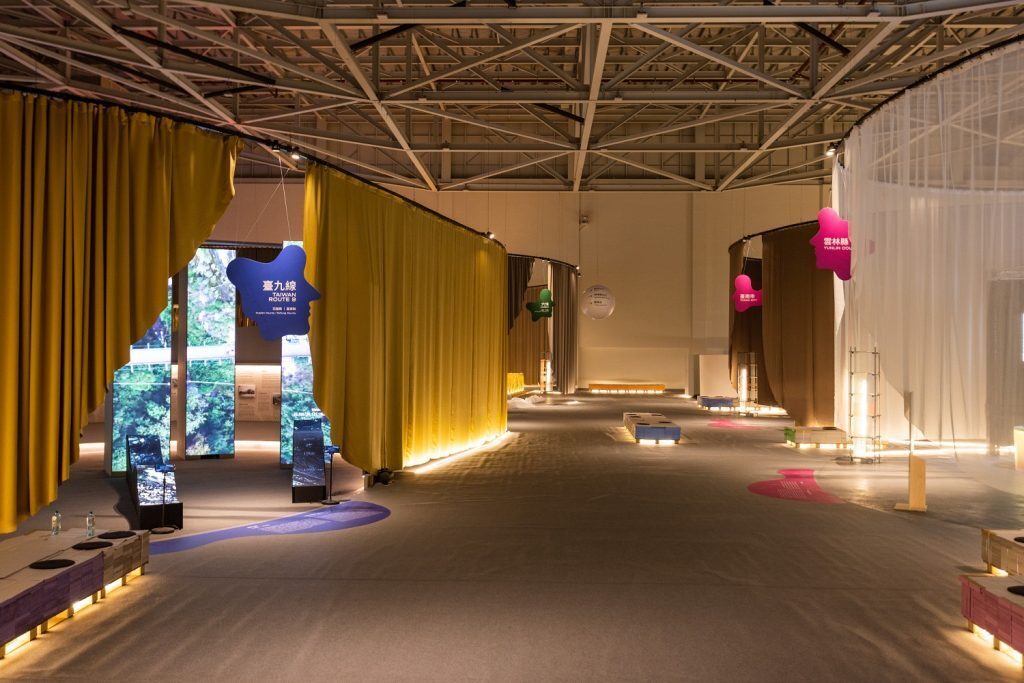
▲ Public areas in Taiwan Pavilion.
Wang provided insights on 3 major themes. For “Adapting Taiwan”, a semi-circular woven fabric wall unfolds the centennial dispersion and migration of the Hakka people. Beneath the large central canopy, models and videos lay out life aspects including cuisine, craftsmanship, and architecture that epitomize distinct local Hakka culture across Taiwan. For “Enriching Taiwan”, historical milestones are chronicled on paper stacks to emblematize the emergence of social movements within past decades, free expression of ideas, and multidisciplinary contributions to national development. For “Taiwan, a Shared Treasure”, a rotating bar counter gathers Hakka and other ethnic groups on one table to portray contemporary expressions in education, local revitalization, and culture. Urban Area: Hakka Identity After Migration to Cities Within the County and City areas of the Taiwan Pavilion, the Hakka 369 route begins with metropolis Taipei and New Taipei, meanders along Taoyuan, Hsinchu, Miaoli, and Taichung on Taiwan Route 3, traversing Hualien and Taitung on Taiwan Route 9, then passing through Nantou, Yunlin, and Tainan to finally arrive at Kaohsiung and Pingtung of the Liugdui in southern Taiwan. Curated by Wooyo Design, the New Taipei City area greets all with the “Hakka in Transition”, embodying community efforts across generations. The Hakka Get-Together captures interesting multi-screen simultaneous interviews of local Hakka elderly, middle-aged, and youth with indigenous peoples and new immigrants. Their different accents vividly shows their diversity and inclusiveness.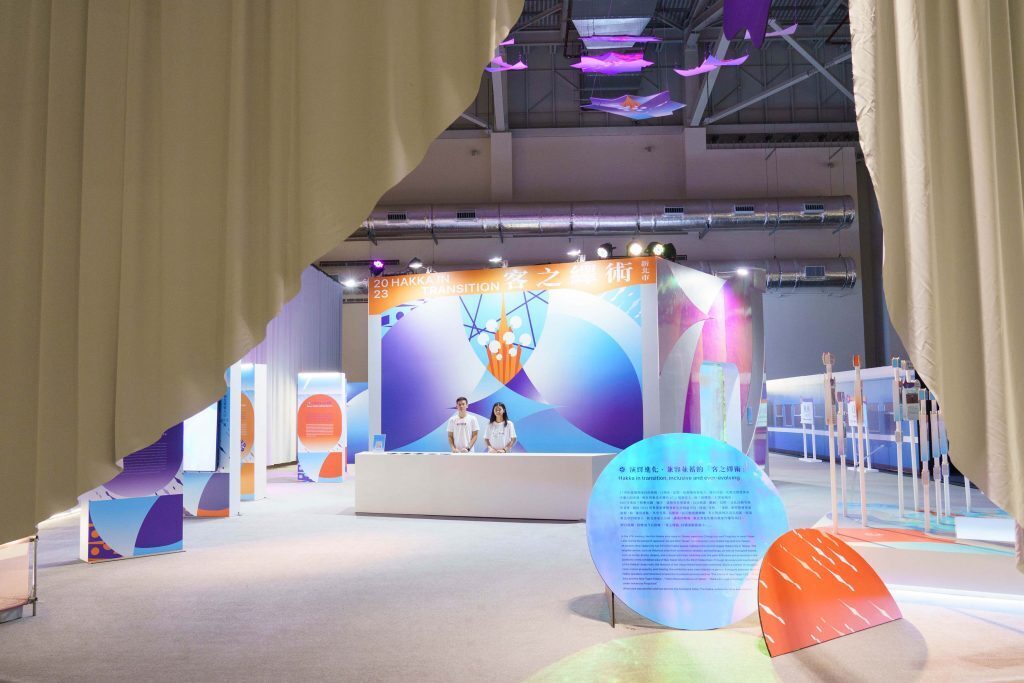
▲ New Taipei City area 「Hakka in Transition」
The Taipei City area, titled “Speaking Out/ Taking Place” and curated by Leo Vision Communication Design, captivates all at the entrance with a replica of a standard train carriage, which transports them to a bygone era when Hakka pioneers moved to Taipei in search of opportunities. Notably, a massive dynamic video wall 15 meters long and 1.5 meters tall repaints a vibrant tapestry of Hakka culture and daily life as reminiscent of the renowned Along the River During the Qingming Festival.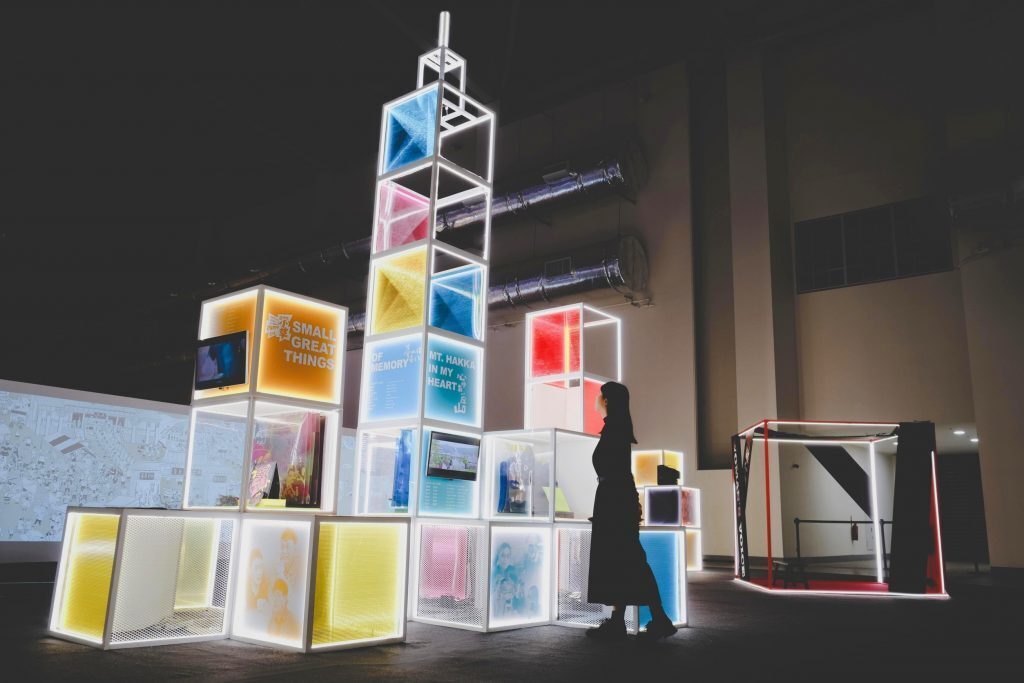
▲ Taipei City area 「Speaking Out/ Taking Place」. Photo credit: Leo Vision Communication Design
Taiwan Route 3 Area: Tracing the Ancestral Journey from Cultivation to Prosperous Trade The Taoyuan City area that marks the start of Taiwan Route 3, is curated by Serendipity Studio, winner of Best Design Award at the 2022 London Design Biennale. The theme “Hakka Infinite Poetics” ingeniously mirrors unique hydro-geographical features from upstream irrigation ponds to coastal estuary. Preferred phrases can be selected on cellphones to compose Hakka poetry that flows into the eye-catching Interactive Irrigation Pond Zone as a stream of words. Attendees were quite charmed by this immersive collective experience, with some exclaiming, “This is incredibly dreamy!”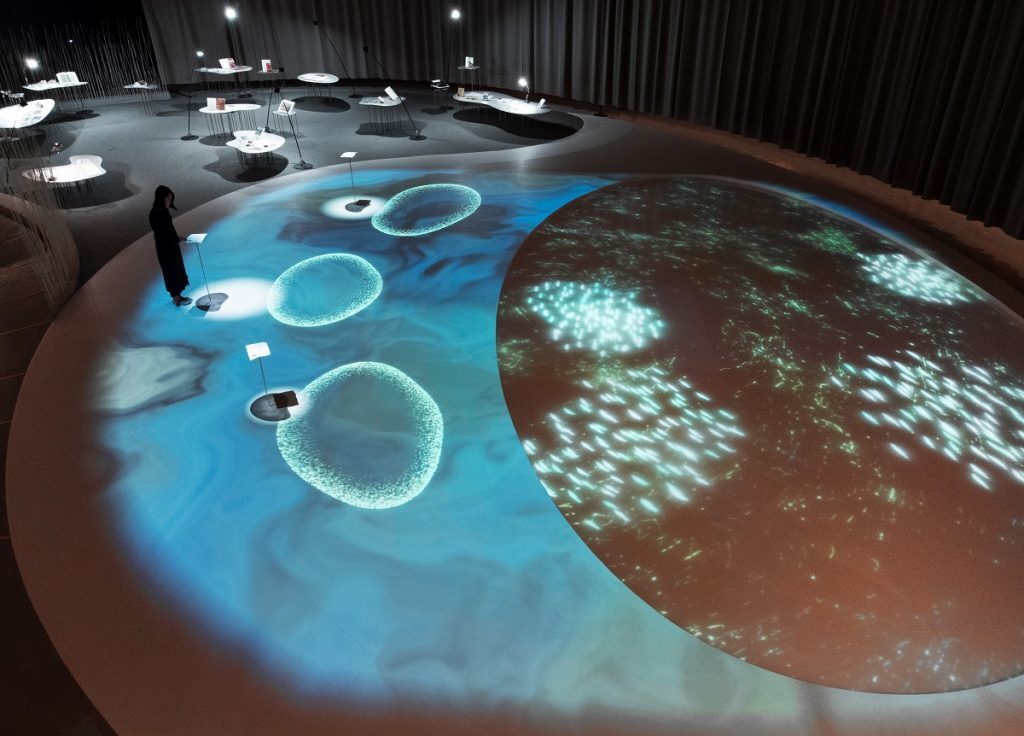
▲ Taoyuan City area 「Hakka Infinite Poetics」. Photo credit: Serendipity Studio
The Hsinchu County and City area were also designed by Serendipity Studio. In Hsinchu County area, the theme is “The Land Where Faith Gathered” with the centerpiece tower of beliefs as a sacred space that engages the senses of sight, sound, and smell with various topics linked by converging lines towards the middle. It not only spotlights the diverse local Hakka culture and the strong sense of unity within.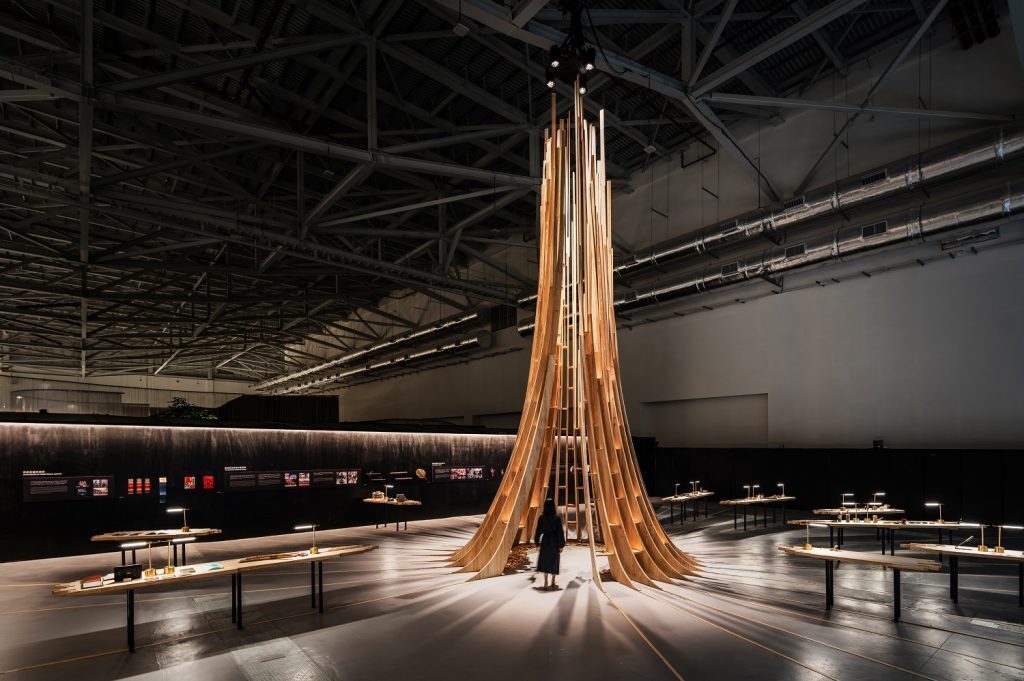
▲ Hsinchu County area 「The Land Where Faith Gathered」. Photo credit: Serendipity Studio
The theme of the Hsinchu City area is “Hakka Alchemy” with the notable site of transformation which translates historical blueprint into an 8-minute projection video. Participants act as industrial workers evolving with advancements in railway, natural gas, glass, chemicals, and high-tech. Interactive artwork is activated by touch and movement, reinvigorating each stage of urban development.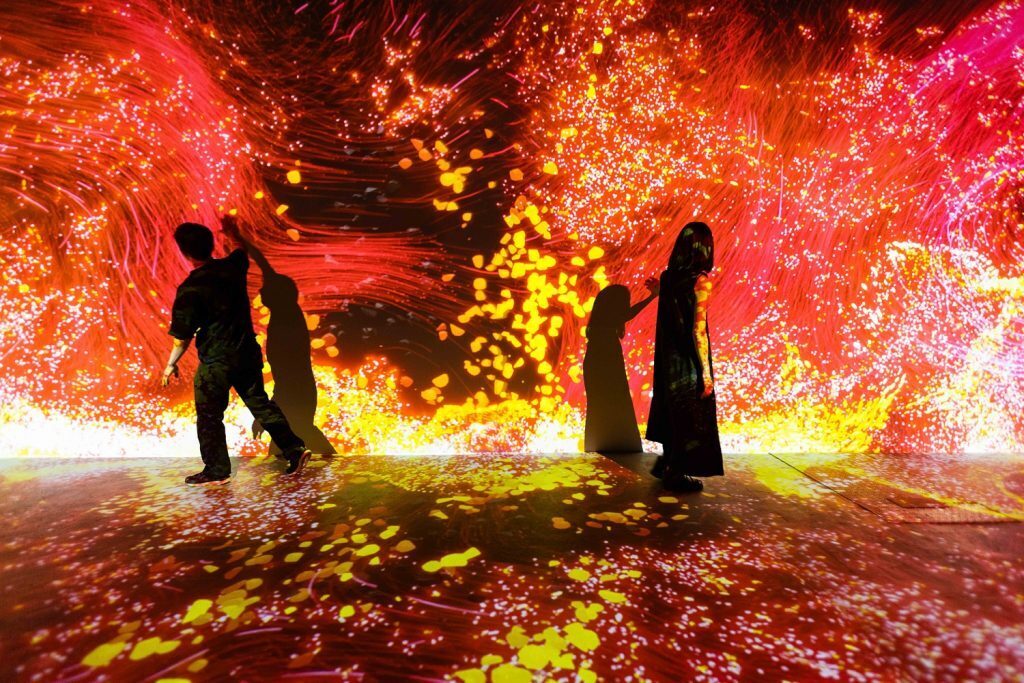
▲ Hsinchu City area 「Hakka Alchemy」. Photo credit: Serendipity Studio
The theme of the Miaoli County area curated by CAM193+ is “Mountain Due”, which rolls overall design into hilly terrain and kilns to uncover the excellence of Miaoli’s pottery, woodwork, literature, and performing arts. The AR multimedia Formosan Leopard Cat’s Secret Realm immerses all in picturesque alpines and forests of past and future local Hakka culture.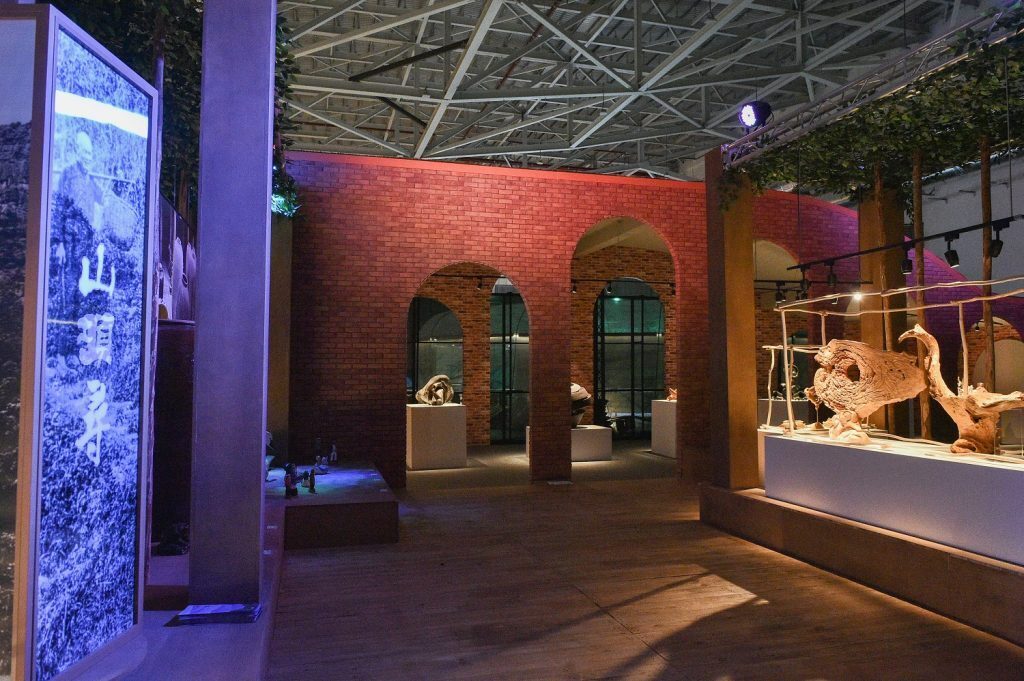
▲ Miaoli County area 「Mountain Due」
As the destination along Taiwan Route 3, the Taichung City area is curated by Plain Design with the theme “The Green-Thumb Hakka—Nature’s Stewards” focused on its inherent ecological philosophy. The wooden tunnel guides all as early settlers in Dongshi carved through mountains for irrigation, to the circular fortress of Dabu settlement, then reaching the circular water wall at the center. As part of a blessing ritual, it signifies Dajia River nourishing the land with abundant resources as a mother who bears witness to the Hakka people’s reverence for nature and water.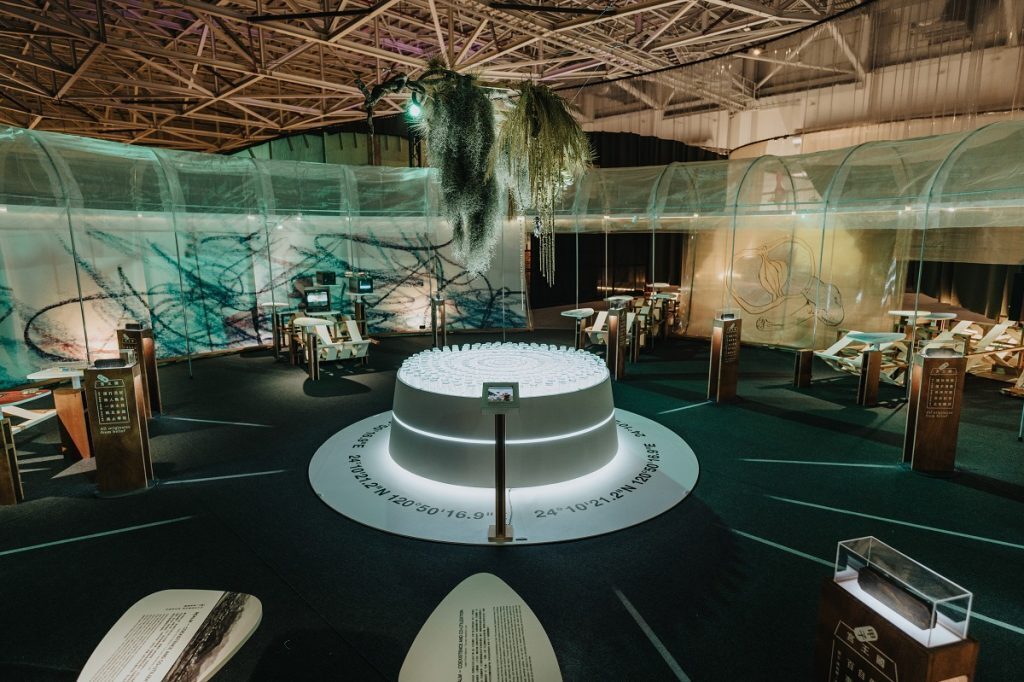
▲ Taichung City area 「The Green-Thumb Hakka—Nature’s Stewards」. Photo credit: Plain Design
Taiwan Route 9 Area: Co-Prosperity of Second-Wave Immigrants and Indigenous Peoples Along Taiwan Route 9, the first Hualien County area is curated by IF Plus under the theme “Sense of Belonging” At the entrance, a “Scenery of Mountains and Waters” is brought to life through large vertical and curved screens depicting the narrative of “Second-Wave Immigrants” who traversed mountains and valleys to establish their homes in Hualien. In the “Culture” section, an immersive 360 projection journeys through time for an experience of the cultural diversity of local Hakka community.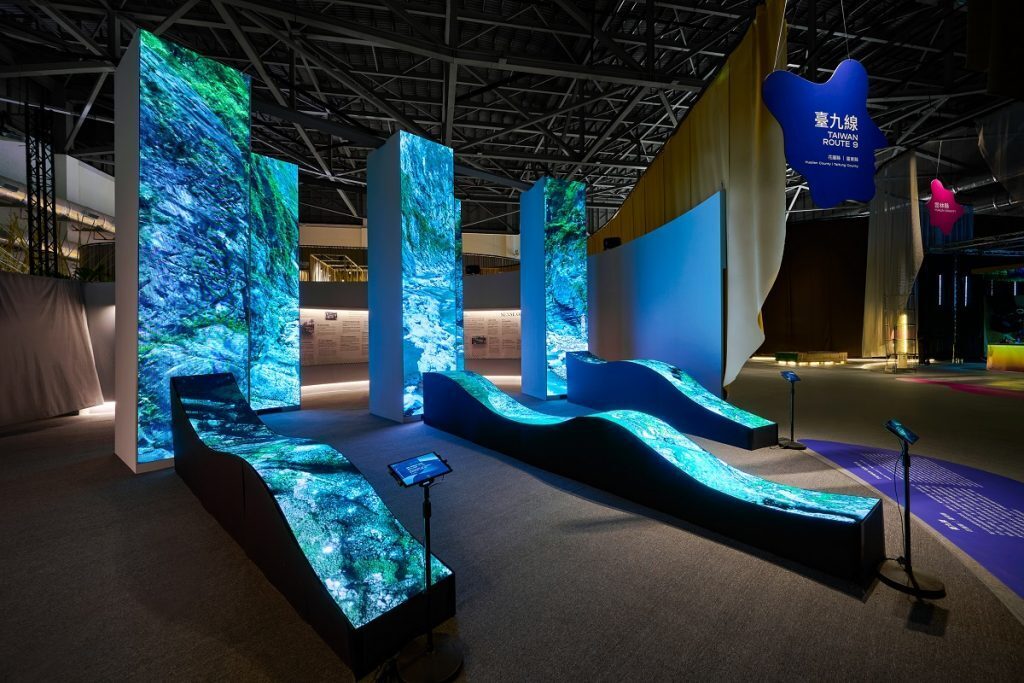
▲ Hualien County area 「Sense of Belonging」. Photo credit: IF Plus
In the Taitung County area, Green Design conceptualized the theme as “Taitung’s Hakka Roots” by first retracing the steps of early pioneers on the Jinshuiying Historic Trail, who navigated challenging paths to cultivate the mountains. Notably, the expansive wooden Pakelang platform weaves traditional farm stonewall with indigenous techniques for shell ginger leaves as a tranquil space to unwind in the unique cultural blend that is essential to Taitung.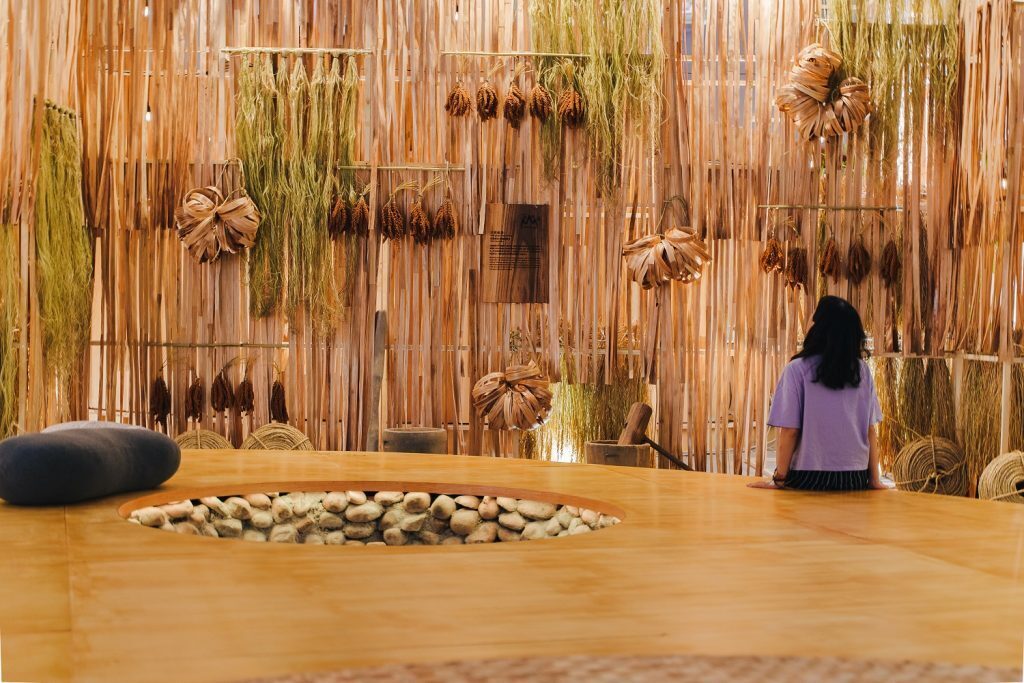
▲ Taitung County area 「Taitung’s Hakka Roots」. Photo credit: Green Design
Independent Exhibition Areas: Unique Hakka Villages and Artisanal Crafts Themed “Hakka Among Hakka – Hakka People of Nantou”, the Nantou County area curated by Seven Apex tells the heartwarming story of locals uniting to rebuild after the devastating 921 earthquake. At the entrance, the immersive interactive Guoxing Qiang Cheng Gong Festival boasts the power of collective effort then follows Hakka farmers who discovered a surviving coffee sapling. Despite adverse conditions, it bloomed to set the local agricultural landscape on the path of coffee cultivation.
▲ Nantou County area 「Hakka Among Hakka – Hakka People of Nantou」
The theme of the Yunlin County area curated by Plain Design is “The Mysterious Hakka-Flavors a Century in the Making.” It not only unmasks local treasures of martial arts, lion dances, and puppetry, but also lays out a striking Hakka family banquet on a tablet. This audiovisual presentations reinterprets 8 traditional dishes using local ingredients and innovative cooking techniques to infuse aromas, textures, flavors, and emotions, refreshing the perspective on culinary traditions.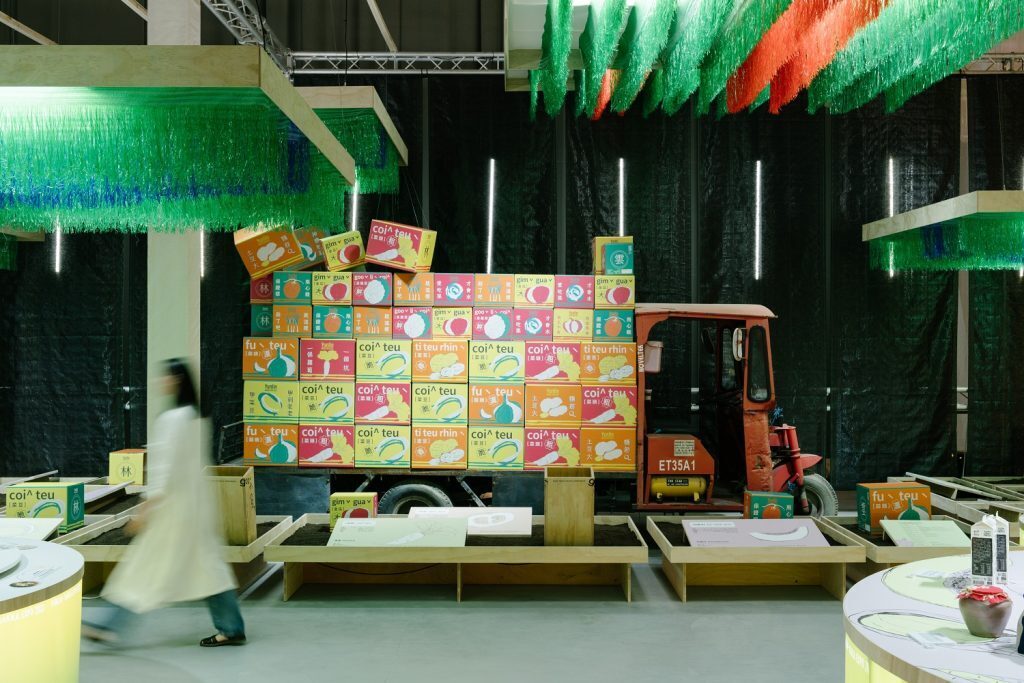
▲ Yunlin County area 「The Mysterious Hakka-Flavors a Century in the Making」. Photo credit: Plain Design
Titled “Hakka in Tainan through 400 Years-A Concealed History,” the Tainan City area is structured by Plain Design around points, lines, and surfaces, tracing historical origins and connecting the inner Hakka of flourishing professions and industries. Despite the lack of prominent Hakka settlements, historical texts and heritage sites unearths local contributions and influences over 4 centuries crucial in shaping and strengthening Taiwan.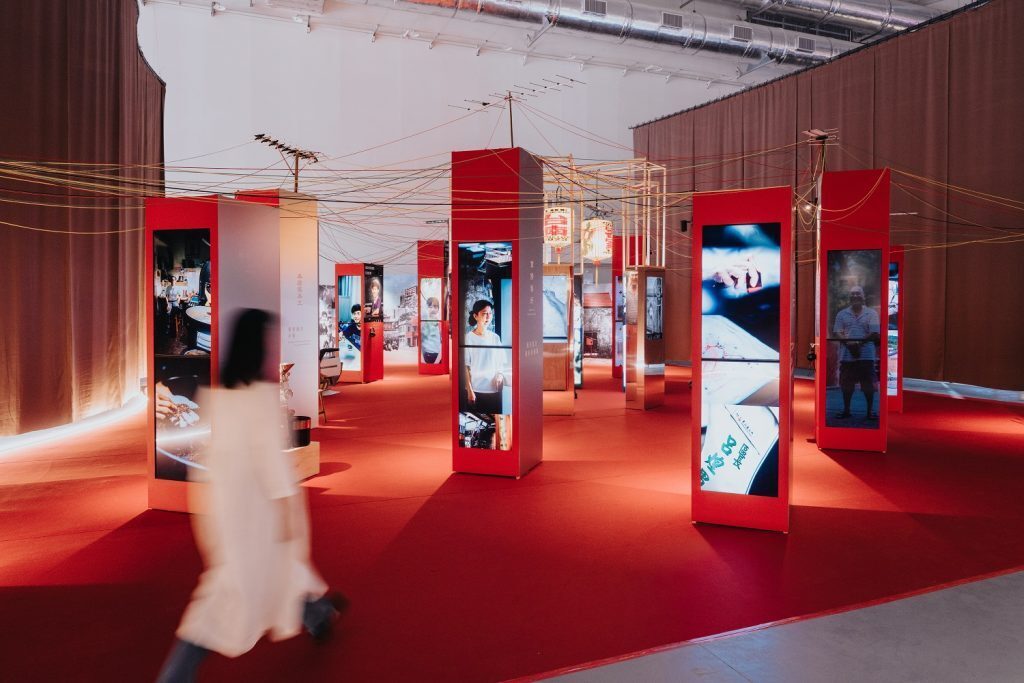
▲ Tainan City area 「Hakka in Tainan through 400 Years-A Concealed History」. Photo credit: Plain Design
Liugdui Area: The United Township Self-Defense Organization of the Plain Basin In the Liugdui region if southern Taiwan, the first stop is Kaohsiung area curated by I’DER Visual Image Design with the theme “Inspire the future, innovate Hakka” Prelude 1736 recounts the migration of the Yudui’s early ancestors down the Minung Mountains along the Laonong River with a culture of farming and studying. Turning 1992 recites the anti-reservoir movement, where young Hakka generations returned to their homeland to advocate for ecological sustainability. Touching 2023 deliniates the boom of arts and culture with Jolin Tsai’s music video and Louis Vuitton collaboration featuring oil-paper umbrellas and bamboo crafts.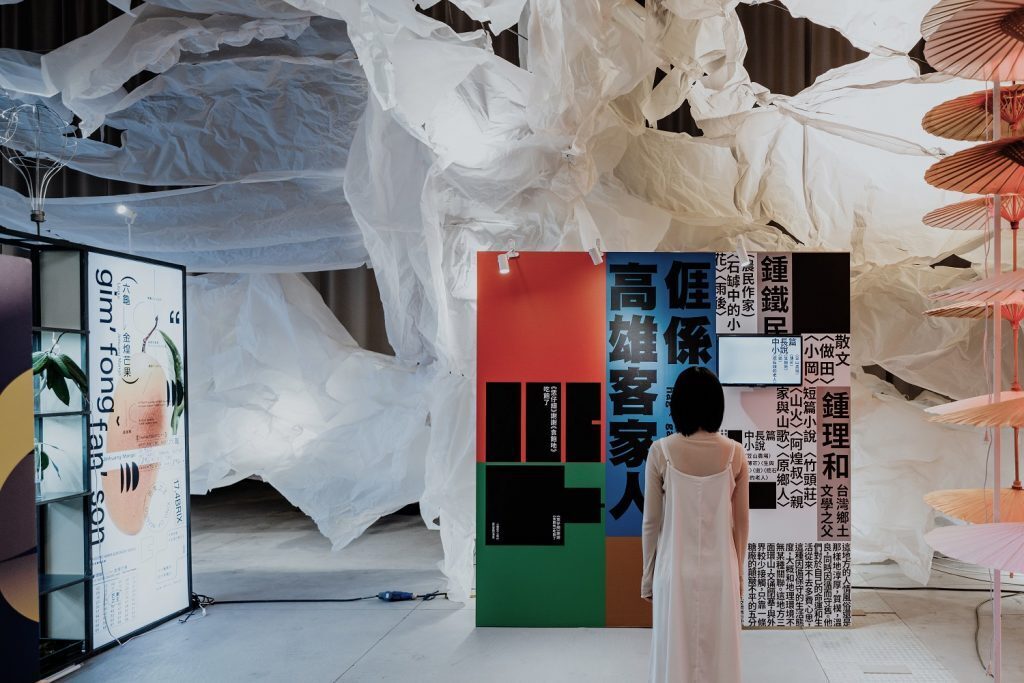
▲ Kaohsiung City area 「Inspire the future, innovate Hakka」. Photo credit: I’DER Visual Image Design
The theme of the Pingtung County area is “Liugdui Hakka” curated by Chu Chih-Kang Space Design. The historical and cultural aspects of Hakka in Liugdui interlaces with the industrial evolution as rice waves sways to the melody of a poem on rich harvests. The large golden vertical balloons create the illusion of an entire rice field that envelopes all in a faint scent, tempting many to take joyful selfies as influencers for the day.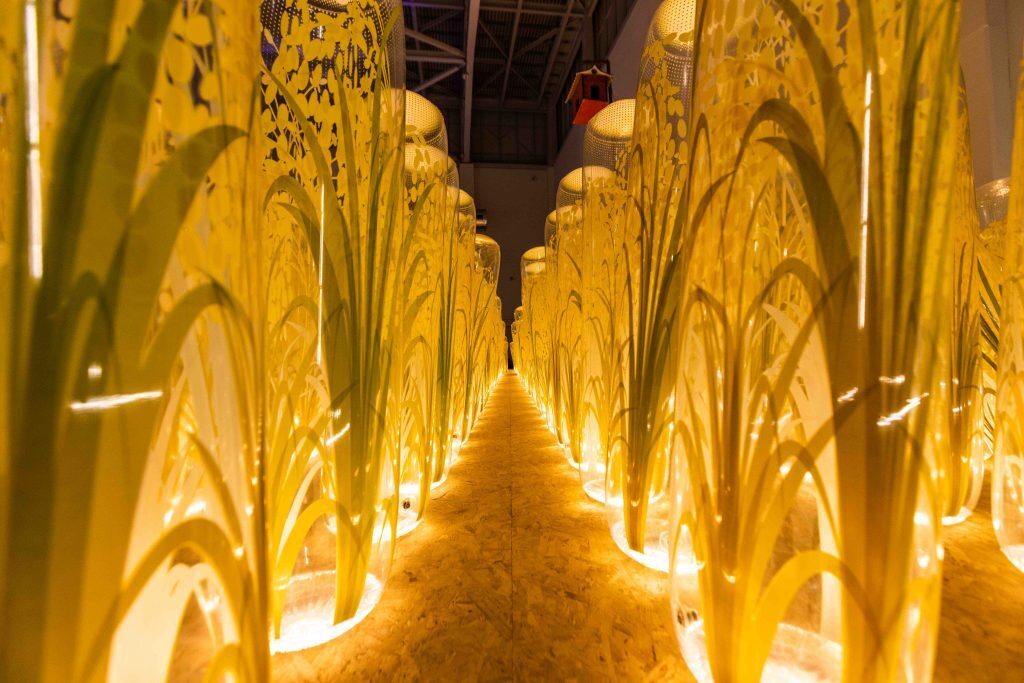
▲ Pingtung County area 「Liugdui Hakka」
Never-ending Brilliance: Digital Displays Reenact the Splendor of the Taiwan Pavilion The 2023 Hakka Expo officially closed on October 15th, evoking nostalgia among many visitors. Mayor Chang San-Cheng recently announced that the meticulously curated exhibitions inside the Taiwan Pavilion will be preserved and reimagined with VR and AR into an immersive Digital Art Exhibition Hall on the 3rd and 4th floors of the World Pavilion. Furthermore, young local artists will be invited to collaborate in curation, allowing the public to engage with new technologies and presentation methods. This ensures that the legacy of the Taiwan Pavilion continues to be celebrated and accessible for years to come.